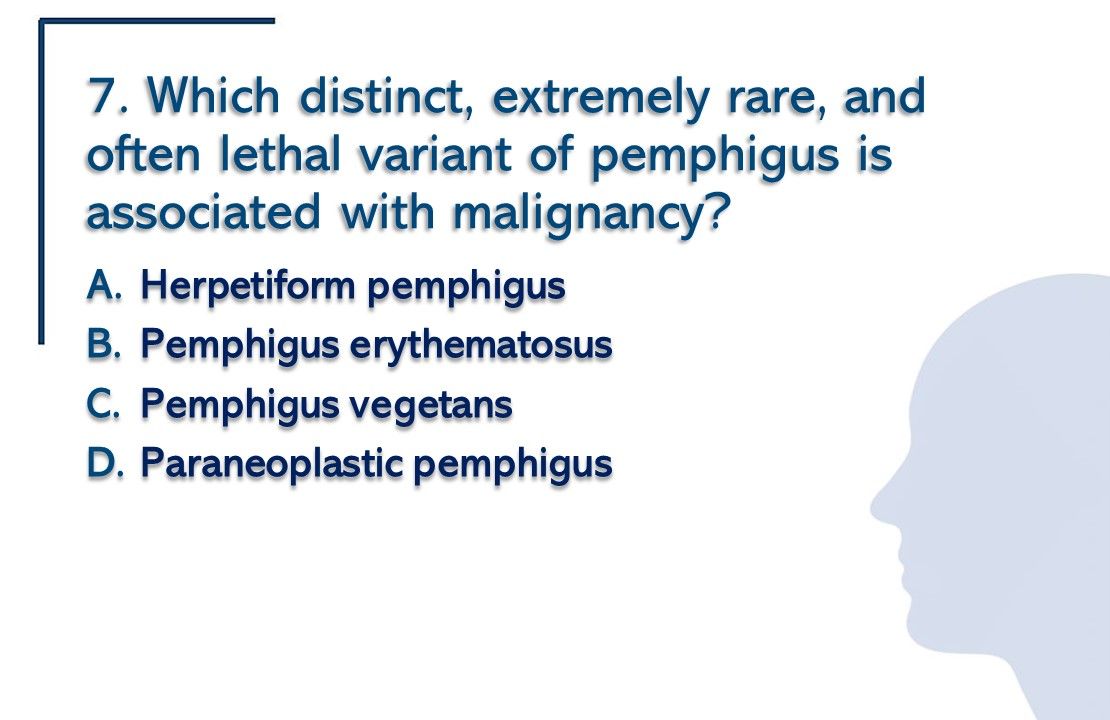© 2025 MJH Life Sciences™ , Patient Care Online – Primary Care News and Clinical Resources. All rights reserved.
Oral Ulcers in Behçet Disease: A Quiz on the Differential Diagnosis
Oral ulceration is common in Behcet disease, but other disorders have similar and overlapping features. Test your knowledge of differential dx in BD.
Oral ulcers are the hallmark of Behçet disease (BD), but because oral lesions are linked with a variety of conditions that have similar and overlapping features, the differential diagnosis becomes a challenge.
Take this quick quiz to find out what you know about oral ulceration in BD and other disorders.

Answer: C. Recurrent aphthous stomatitis. The condition presents as painful, round, shallow ulcers with a well-defined erythematous margin and yellowish-gray pseudomembranous center, typically on the buccal and labial mucosa and tongue. Cyclic neutropenia, Crohn disease, and recurring intraoral herpes infections, as well as BD, are among the oral ulcer–causing diseases that may be mistaken for stomatitis.

Answer: D. ≥ 6. BD oral ulcers are variable in size, with surrounding erythema and with involvement of the soft palate and oropharynx.

3. Oral aphthous ulcers, the hallmark of BD, are present in roughly what percentage of patients with lupus?

Answer: B. 50%. The classic appearance of oral aphthous ulcers in lupus is that of a whitish plaque with central erythema and peripheral keratotic striae. Lichenoid mucositis and discoid lesions are other oral lesions in lupus. The lesions may be confused with erythema multiforme and vesiculobullous lesions.

4. Oral lichen planus lesions have distinct, uniform clinical features that make it easy to differentiate from other causes of oral ulceration. True or false?

Answer: B. False. The clinical features are highly variable, ranging from subtle white reticular patterns to erosions and ulcerations. Lesions in the oral cavity usually are distributed symmetrically, affecting the buccal mucosa, tongue, gingiva, and other sites. They may be confused with those of lupus, pemphigoid, pemphigus, chronic ulcerative stomatitis, and lichenoid drug reactions.

5. Which autoimmune bullous disease above features oral lesions characterized by subepithelial blistering?

Answer: A. Mucous membrane pemphigoid. In this condition, oral lesions present in the gingiva, where desquamation appears as patches or widespread erythema. Patients present with tense serous or hemorrhagic bullae that easily rupture, leading to irregularly shaped erosions or ulcers with yellowish slough surrounded by an erythematous halo.

6. The oral mucosa is the first site involved in what percentage of patients who have pemphigus vulgaris?

Answer: C. 50% to 80%. Pemphigus diseases are characterized by intra-epithelial blistering. In pemphigus vulgaris, erosions are displayed more often than intact blistering. The palatal mucosa, buccal mucosa, labial mucosa, and tongue are most often affected. Desquamative gingivitis is seen in about one-fourth of patients.

7. Which distinct, extremely rare, and often lethal variant of pemphigus is associated with malignancy?

Answer: D. Paraneoplastic pemphigus. The main clinical sign is involvement of the mucosa, predominantly the oral mucosa. Oral lesions include painful stomatitis, gingivitis, hemorrhagic cheilitis, erythema, blistering, and erosions. There may be underlying B-cell lymphoproliferative diseases.

8. Stevens-Johnson syndrome/toxic epidermal necrolysis (SJS/TEN) can damage mucous membranes, including the lining of the mouth. True or false?

Answer: A. True. In SJS/TEN, a severe skin reaction triggered by medications, there is an abrupt onset of erosive stomatitis and hemorrhagic cheilitis, followed by widespread skin lesions. The gingiva are rarely affected. Other drug-induced diseases that may cause oral lesions include methotrexate mucositis and gingivostomatitis by checkpoint inhibitors.
For more information on all questions and answers, please visit “Oral Ulcers in Behçet Present Difficult Differential.”




